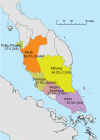Macacine Herpesvirus 1 in Long-Tailed Macaques, Malaysia, 2009-2011
- PMID: 26080081
- PMCID: PMC4480374
- DOI: 10.3201/eid2107.140162
Macacine Herpesvirus 1 in Long-Tailed Macaques, Malaysia, 2009-2011
Abstract
Macacine herpesvirus 1 (MaHV1; B virus) naturally infects macaques (Macaca spp.) and can cause fatal encephalitis in humans. In Peninsular Malaysia, wild macaques are abundant, and translocation is used to mitigate human-macaque conflict. Most adult macaques are infected with MaHV1, although the risk for transmission to persons who handle them during capture and translocation is unknown. We investigated MaHV1 shedding among 392 long-tailed macaques (M. fascicularis) after capture and translocation by the Department of Wildlife and National Parks in Peninsular Malaysia, during 2009-2011. For detection of MaHV1 DNA, PCR was performed on urogenital and oropharyngeal swab samples. Overall, 39% of macaques were shedding MaHV1 DNA; rates of DNA detection did not differ between sample types. This study demonstrates that MaHV1 was shed by a substantial proportion of macaques after capture and transport and suggests that persons handling macaques under these circumstances might be at risk for exposure to MaHV1.
Keywords: B virus; Macaca fascicularis; Macacine herpesvirus 1; Malaysia; PCR; encephalitis; herpes B virus; long-tailed macaque; nonhuman primate; occupational risk; translocation; viruses; zoonoses.
Figures
References
-
- Palmer AE. B virus, herpesvirus simiae: historical perspective. J Med Primatol. 1987;16:99–130 . - PubMed
-
- Holmes GP, Chapman LE, Stewart JA, Straus SE, Hilliard JK. Guidelines for the prevention and treatment of B-virus infections in exposed persons. Clin Infect Dis. 1995;20:421–39 Davenport DS. 10.1093/clinids/20.2.421 - DOI - PubMed
Publication types
MeSH terms
LinkOut - more resources
Full Text Sources
Other Literature Sources
Miscellaneous


